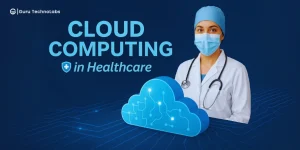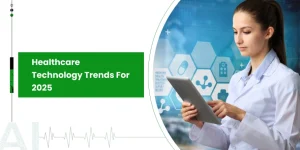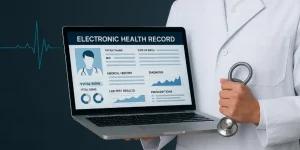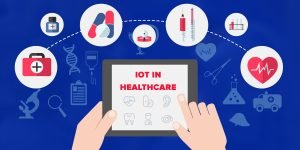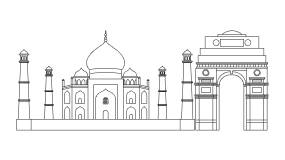Healthcare Mobile App Development: Steps to Build a Successful App

Health care is not what it used to be, confined to the local clinic or hospital. With new technology blooming every day, the healthcare industry is shifting to a digital ecosystem, delivering more accessible, efficient, and personalized care.
Patients expect to be able to take their health into their own hands from their fingertips, from telemedicine and appointment scheduling to an online medical record. This digital transformation in healthcare enables greater innovation and responsiveness in medicine than we’ve ever seen, improving the patient experience, as well as the associated healthcare delivery efficiencies.
Healthcare apps are leading the charge in this revolution. These apps cover everything from mental health care to chronic illness management. In this blog, we are going to discover the steps towards creating a successful healthcare app for users & doctors.
What is Healthcare App Development and Its Market Demand?
Healthcare app development refers to creating mobile applications specifically for the healthcare sector, aimed at improving medical services, streamlining processes, and enhancing communication between patients and healthcare providers. These apps empower users by bringing essential health services directly to their fingertips, supporting a more efficient and accessible healthcare system.
A report by Grand View Research estimated that the global healthcare app market was forecasted to grow at a CAGR of 14.9% and reach a value of $42.32 billion in 2023.
The growth of the healthcare app market highlights the appreciation of users for the convenience, accessibility, and enhanced care that healthcare mobile applications can provide. As healthcare tech trends continue to transition into the digital space, there is a growing demand for innovative and user-friendly apps in this area, so healthcare app development is a fascinating and lucrative field.
If you’re exploring healthcare app ideas, consider creating niche apps such as women’s health trackers, mental wellness assistants, or platforms for remote rehabilitation therapy. These ideas tap into underserved markets and align well with emerging patient needs in 2025.
Step-by-Step Process of App Development for Healthcare
Developing a healthcare app is an exciting journey that requires careful planning and strategic decision-making. Whether you are aiming to improve patient experience, simplify healthcare management, or innovate healthcare delivery, following a structured approach ensures your healthcare app meets both user needs and business goals.
Let’s break down the key steps you need to follow in healthcare mobile app development.

Consider Your Capabilities
Before diving into app development for healthcare, it’s important to evaluate your capabilities and resources. This involves assessing the skills of your development team, your technological infrastructure, and your available budget.
Understanding what you can realistically achieve will help you make informed decisions about the complexity of the app you want to build. Whether you plan to develop a simple app with basic functionalities or a feature-rich platform that integrates with healthcare databases, knowing your capabilities will guide the overall direction of the project.
Pinpoint Your Needs
Next, you should outline the purpose of your healthcare app. “Are you looking to offer telemedicine, help patients manage chronic conditions, or simplify the scheduling of appointments?”
Understanding the specific needs of your healthcare domain will guide you in prioritizing which features and functionality to go with. This is also where you identify which types of healthcare software your app aligns with.
This process makes sure your app is a solution to real problems like helping doctors monitor the vitals of patients outside the hospital or enabling patients to check their medical health records easily.
Identify Your Users
Identifying your target audience is integral to the success of your healthcare app. Different users — patients, healthcare providers, caregivers, or insurance companies — will have unique needs and preferences.
For instance, if you are building an app for the elderly, you will need larger fonts, simple navigation, and accessibility features, while in the case of a healthcare app that would be used by doctors, you might want to consider advanced medical tools, patient management systems, and data security.
Choose the Monetization Model
When it comes to how to develop a healthcare app, deciding on a monetization model is a crucial step. There are several monetization strategies you can implement, depending on the type of the app and the value it offers.
1. Freemium Model: This model allows users to download the app for free but offers premium features or functionalities at a cost.
2. Subscription Model: This is one of the most common models for healthcare apps, where users pay a recurring fee to access premium content or features.
For instance, telemedicine apps like Teladoc or Amwell typically operate on a subscription basis, where users pay for unlimited consultations or a fixed number of consultations per month.
3. Pay-Per-Service: In this model, users are charged each time they access a particular service.
For example, an app that connects patients with medical professionals for one-time consultations might charge users for each session.
4. Advertising Model: Some healthcare apps integrate ads to generate revenue. This model is often used in free-to-use apps and can be effective if you have a large user base.
Choose the Application Type
Healthcare apps can be divided into several categories, and choosing the right type for your project is essential. Common types of healthcare apps include:
1. Telemedicine Apps: Apps that facilitate online consultations with doctors, allowing patients to access medical advice remotely. Examples include Doctor on Demand and MDLive.
2. Fitness and Wellness Apps: These apps focus on health tracking, exercise, diet, and mental well-being. Popular examples are MyFitnessPal and Headspace.
3. Chronic Disease Management Apps: These apps assist patients in managing chronic conditions like diabetes, hypertension, or asthma. An example is BlueLoop, which helps manage diabetes by tracking blood glucose levels.
Choosing the right type helps you focus on the features and functions that matter most to your users.
Choose the Platform
When choosing a platform for the healthcare app, you will have to consider iOS, Android, or cross-platform mobile app development. What you choose depends on your cost and your audience.
- iOS applications have a higher monetization potential, but development may be more expensive. But on average, iOS users are more willing to pay for premium offerings.
- Using Android apps is more prevalent across the globe, and developing on Android generally provides more leeway with app functionality.
- Also, cross-platform development tools are emerging like React Native or Flutter which allows you to build apps for iOS and Android with a single codebase, thus saving time and resources.
Your platform choice should align with your target market, budget, and the devices your users most commonly use.
Create MVP (Minimum Viable Product)
MVP is a crucial part of the healthcare app development process. The goal is to create a stripped-down version of your app with the essentials that will respond directly to the users’ problems.
This not only allows you to try out the concept in the real world but also gather feedback that can prove invaluable when it comes to creating the full-sized version of the app.
A telemedicine app, for example, might launch to offer only video consultation and later add features like appointment scheduling and prescription management based on user feedback. MVP development will help you validate your concept, attract early adopters, and iteratively improve.
Design and Develop
Once you have a clear understanding of your app’s purpose and features, it’s time to design and develop the app. Focus on creating an intuitive and user-friendly interface, as healthcare apps are often used by individuals who may not be very tech-savvy.
The design should prioritize accessibility, ensuring that users can easily navigate the app regardless of age or technical knowledge.
Additionally, security and data privacy are important, especially when handling sensitive healthcare information, implementing secure features like encryption, and compliance with healthcare regulations. (e.g.HIPPA in the USA).
A/B Testing for Healthcare App
A/B testing is a crucial part of refining your healthcare app. By testing different versions of features, design elements, and functionality, you can determine which version resonates most with your users.
For example, you might test two different layouts for a patient dashboard to see which one leads to higher user engagement. A/B testing helps you make data-driven decisions to improve your app’s performance and user experience.
Assess Your Outcomes
Finally, after launching your app, it’s essential to assess its performance and gather feedback from users. Use analytics tools to track key metrics like user engagement, session length, retention rates, and user satisfaction.
This will help you identify areas for improvement and fine-tune the healthcare app to meet users’ needs more effectively. Regularly update your healthcare app with new features and bug fixes based on this feedback to ensure it remains relevant and useful.
By following the above steps, you can successfully develop a healthcare app that addresses user needs, complies with industry standards, and delivers a seamless and secure experience.
Want to Know, How can You Integrate AI into Your Platform?
Connect with us! Our experts will help integrate AI to improve user experience,
increase efficiency, and help your dating platform succeed.
Benefits of Healthcare Mobile App Development for Medical Professionals and Patients
Healthcare is rapidly leaning on technology such as AI in healthcare, and Cloud Technology, offering significant improvements in efficiency and care for both medical professionals and patients. Mobile healthcare apps are central to this transformation, making healthcare services more accessible, effective, and streamlined.
Below, we outline some unique benefits for both medical professionals and patients.
| Stakeholder | Benefits |
|---|---|
| Medical Professionals | Real-Time Patient Monitoring: Easily track patient progress remotely, ensuring timely interventions. |
| Streamlined Workflow: Automated tasks reduce administrative burden, allowing more focus on patient care. | |
| Enhanced Collaboration: Share patient data securely with colleagues, improving team-based care. | |
| Data-Driven Insights: Leverage patient data analytics for more informed clinical decisions. | |
| Patients | Remote Consultations: Access healthcare from the comfort of home, reducing the need for office visits. |
| . | Personalized Health Tracking: Track and share vital health metrics in real time with healthcare providers. |
| Health Education: Access resources that help patients better understand and manage their conditions. | |
| Easy Appointment Management: Schedule, reschedule, or cancel appointments quickly, reducing waiting times. |
These benefits highlight how healthcare apps improve service delivery, making healthcare more efficient and accessible for both medical professionals and patients.
Make the Most of Healthcare App Development with Guru TechnoLabs
As we step into 2025, the demand for tech-enabled healthcare solutions continues to soar. Healthcare app development has become a key driver in making healthcare services more personalized, streamlined, and easily accessible.
With Guru TechnoLabs, you don’t have to settle for anything less than excellence. We know that building a successful healthcare app goes beyond just coding. It’s about creating an experience that truly improves lives, enhances patient engagement, and meets regulatory standards. That’s why we’re here – to partner with you every step of the way and help you navigate the ever-changing healthcare landscape with ease.
Don’t wait for the future to catch up with you – reach out to us today, and let us bring your healthcare app vision to life. With our expertise, the future of healthcare is just a tap away!
Frequently Asked Questions
The approximate time of building a healthcare app ranges from five to six months depending on the project complexity, feature set, design, and location of the development team.
It would be ideal to create your healthcare app by HIPPA if it gathers, handles, and transmits any protected health information. This guarantees that the patient's medical records are safe and will only be accessed for research and diagnosis.
There are many types of healthcare apps including:
- Telemedicine apps
- Wellness apps
- Medication management apps
- Health education apps
- Patient management systems
- Women’s health apps
- Medical record app
- Prescription apps
The majority of medical applications make money through membership fees and in-app advertisements. Additionally, you can sell anonymized patient data and provide pertinent in-app purchases to support additional studies and produce insightful findings.



